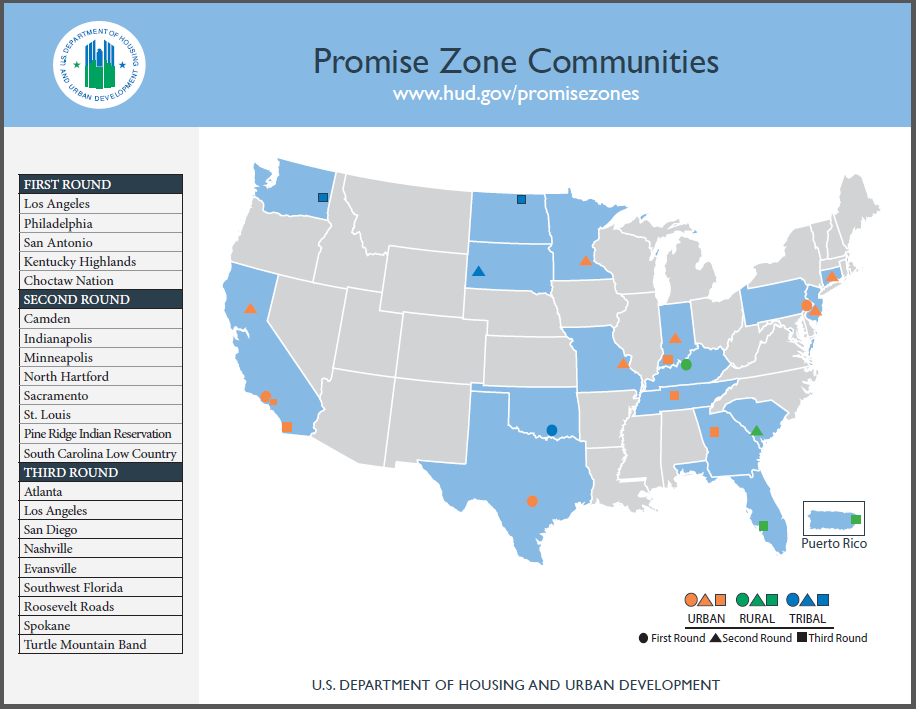Nine new Promise Zones join 13 others to expand economic opportunity in distressed areas.
HUD named the final nine Promise Zones (PZ) across the country – high poverty areas in select urban, rural and tribal communities. Through the Promise Zone Initiative, the Federal government will work strategically with local leaders to boost economic activity and job growth, improve educational opportunities, reduce crime and leverage private investment to improve the quality of life in these vulnerable areas.
- Atlanta, Georgia
- Evansville, Indiana
- Nashville, Tennessee
- Roosevelt Roads, Puerto Rico
- San Diego, California
- South Los Angeles, California
- Southwest Florida Regional Planning Commission
- Spokane Tribe of Indians, Washington
- Turtle Mountain Band of Chippewa Indians, Rolette County, North Dakota
Background on Promise Zones:
The above designated Promise Zones joined 13 others designated in 2014 and 2015. These Promise Zones include targeted neighborhoods in the following communities:
- Camden, New Jersey
- Choctaw Nation of Oklahoma
- Hartford, Connecticut
- Indianapolis, Indiana
- Los Angeles, California
- Minneapolis, Minnesota
- Philadelphia, Pennsylvania
- Pine Ridge Indian Reservation of the Oglala Sioux Tribe, South Dakota
- Sacramento, California
- San Antonio, Texas
- South Carolina Low Country
- Southeastern Kentucky Highlands
- St. Louis/St. Louis County, Missouri
Work is well underway in these communities and demonstrating results. For example:
- In Indianapolis, the IndyEast Promise Zone has already secured nearly $10 million in federal grants across seven different agencies. This support has helped create 110 jobs, provide life-changing workforce training to hundreds of formerly incarcerated individuals, and develop a new energy efficient apartment building for low-income senior citizens.
- In North Minneapolis, the U.S. Department of Agriculture (USDA) awarded Appetite for Change (a locally-led organization) a Community Food Project grant to help continue and expand programs that are changing the way food is produced, marketed, distributed and consumed in North Minneapolis. This project has served over 1,000 community members, with 24 youth employed and trained and 15 jobs created, aiding 53 community-owned food business start-ups.
- In San Antonio, the Promise Zone to Work Initiative was launched and has since provided free job training certifications in nursing, construction, manufacturing, information technology, and heavy equipment for 106 residents. This effort is contributing to an overall decline in the unemployment rate; over the last four years, unemployment in the Promise Zone declined from 15 percent to 11 percent.
- In Southeastern KY, a new educational framework and support from AmeriCorps VISTA members helped lift the graduation rate at Leslie County High School from 67 to 98 percent.
- The Choctaw Nation has secured $21 million in New Markets Tax Credits to build an environmentally sustainable steel manufacturing facility in the Promise Zone. The facility will support approximately 300 new jobs in the region.
Today’s Promise Zone communities were selected from 82 applications from 38 states and Puerto Rico. Each urban, rural, and tribal Promise Zone applicant was asked to put together a clear description of how the Promise Zone designation would accelerate and strengthen the community’s own efforts at comprehensive community revitalization. Each Promise Zone will be coordinated by a lead community based organization. HUD will be the federal lead for the 14 urban designees, while USDA will serve as the lead federal partner to the tribal and rural Promise Zones.
All Promise Zones will receive priority access to federal investments that further their strategic plans, federal staff on the ground to help them navigate federal resources, and five full-time AmeriCorps VISTA members to recruit and manage volunteers and strengthen the capacity of the Promise Zone initiatives.
Join the mailing list to receive announcements and to follow the progress of the Promise Zones.
- Community Development Marketplace
- Communications, Reporting & Data
- Designees, Finalists & Applicants
- Guidance for Preference Consideration
- Fact Sheet
- Funding and Technical Assistance
- Promise Zone Federal Programs
- Promise Zones Overview
- Third Round Press Release
- Third Round Selection Process FAQs
- Urban PZ Data and Evaluation


